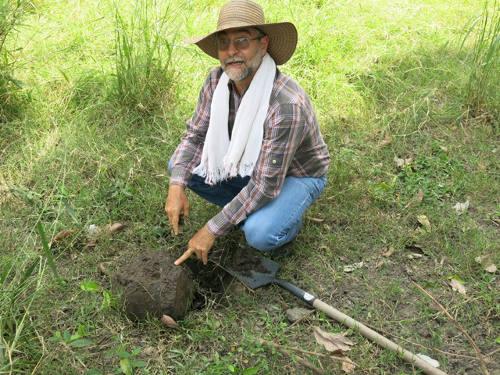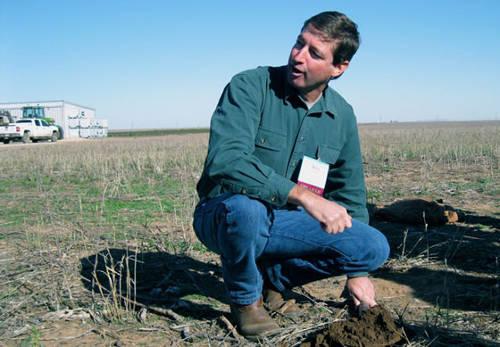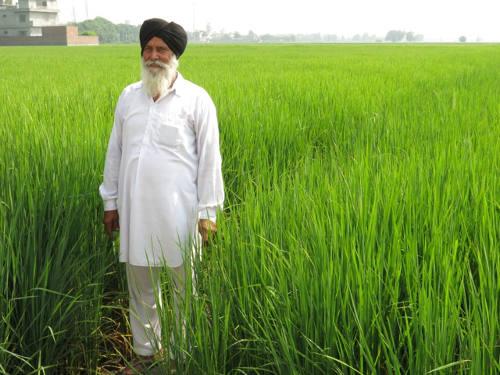From the drought-plagued Valle del Cauca in Colombia to the High Plains of West Texas, farmers are learning to work with the land instead of against it.
This article was originally published at Environmental Health News
Carlos Hernando Molina pressed his boot onto the shovel and the blade cut into the earth. He rocked the handle, turned over the clump of soil, and fingered the dirt to point out the worms, bugs and plant fibers as the soil crumbled.
His land was alive. Worms twisted and beetles scurried to hide. Microorganisms were there, too, but you couldn’t see them working to help plant fibers decompose, making the soil ready to supply nutrients to roots. The shovel-full of soil was the definition of healthy, but it didn’t always look this way.

Much of the agricultural land devoted to grazing cattle around Molina’s farm in Latin America—and pastures in the U.S.—does not look like his, which contain tree-lined fields that are planted with dense layers of shrubs, grasses, and ground cover. Open grassland or vast acres of monocrop land is more the norm.
But the open land is susceptible to the loss of topsoil from wind and heavy rain, the loss of moisture from increasing cycles of drought, and a decline in nutrients that crops need to grow. In coastal areas, soils are increasing in salinity. In parched areas, it’s blowing away.
Farmers, researchers and development agencies are all increasing their focus on soil. Globally, change in the way land is used and managed puts pressure on soils to do more. Farmers are growing more monoculture crops; rotating them less; and leaving behind pesticide residues, polluted waters from fertilizer run off, carbon loss, and depleted aquifers.
Molina and other farmers I’ve met with over the years are bucking the trend. Their attention to soil has been a business decision, leading to increased production and yields, and has helped them withstand weather extremes.
It’s catching on: In a recent survey, insight from 2,020 farmers from across the United States reflected enthusiasm for cover crops to help improve soils—for the fourth year in a row—and found a yield boost in corn and soybeans following cover crops.
In West Texas, for example, Barry Evans has not plowed his fields in 20 years. By leaving the dried stubble in the fields where he grows sorghum and cotton, he said he “banks the water,” describing how he retains moisture from precious droplets of rain. By not tilling the fields, the residue from cotton, sorghum and wheat grown as a cover crop has created an organic mat that protects the soil from wind and shatters rain drops as they fall, gently dispersing the water and allowing it to filter into the aquifer.
In northern Punjab, India, I met with Joginder Singh in the months after he had used a new method of planting rice amid the wheat stubble that was left over from the previous season’s harvest. His soil had been degraded from decades of tillage and burning the fields. But by not tilling the wheat after harvest, his soils could drain more readily and still keep water available to plant roots.
When heavy rainfall occurred, other fields that didn’t contain as much organic matter choked from the deluge—while his fields drained. The added ability for his soils to absorb moisture means he spends less time irrigating his rice crop.
Molina, Evans, and Singh are among the many farmers who are adopting new techniques to improve the quality, function and processes of their soil. They are countering threats to soil quality—and in turn, improving what their farms produce—by enriching soils with organic matter, protecting soils from tilling and other disturbances, and planting cover crops.
“Improving soil health is like growing an asset”
Soils are a hidden world—much like oceans. Soils are vast and the foundation of agriculture and biodiversity, but little is known about them. Soils behave differently in different regions of the world.
Kate Tully, assistant professor of agroecology at the University of Maryland, works with farmers to improve their soil in vulnerable areas around the world, including the U.S. and in tropical regions. She has studied soils in areas ranging from Brazil to Kenya, which both have deep soils and a large capacity for nutrient uptake. The soils are 10 to 12 meters deep. Compare that to eastern Maryland, where she can drill down a meter and hit water.

Soils “are the great integrator,” Tully said. “Plants have to grow in them, the water has to move through them, and it is critical that we have a better understanding of the types and distributions of soils across the planet.”
Paul West, co-director and lead scientist of the Global Landscapes Initiative at the University of Minnesota’s Institute on the Environment, said keeping soils healthy is a great balancing act. It’s better to build up organic matter in the soil because it increases the ability for soils to hold water.
West said that the importance of soils cannot be underestimated.
For farming and sustainable development, “improving soil health is like growing an asset,” West said. “Soil that stays on the farm is also great for keeping our rivers clean of sediment, pesticides, and fertilizers. Cover crops, stream buffers, and other management practices to hold soil in place also provide wildlife habitat and pulls carbon dioxide out of the air and stores it in the ground.”
Richer soils mean that more water is available to plants as they are getting started in the season and organic matter is able to hold nutrients well, West explained. “The organic matter acts as a bank of nutrients like nitrogen, phosphorous, calcium, and potassium that are more slowly released and these nutrients are available throughout the season. In contrast, nitrogen fertilizers don’t stick around in the soil very long.”
Evans knows all about growing his soil as an asset. He was among the first in his Texas High Plains region, part of the former “Dust Bowl”, to adopt conservation farming after a May 1996 windstorm blew away the dirt in a field he planted; he lost almost the entire crop. Since then, he has shared the soil and water conservation techniques of his cotton-and-sorghum no-till methods with neighboring farmers.
Water is a valuable commodity for Evans. When I visited his farm in the fall of 2012, just five inches of water fell as rain the previous year and 10 inches fell that year. The water he uses for irrigating his cotton comes from the Ogallala aquifer, which is also facing a crisis. In 2012 a U.S. Geological Survey study estimated that the depletion of the Ogallala means that the southern High Plains will not be able to irrigate 35 percent of the land in the next 30 years.
Over in India, some of Joginder Singh’s neighbors are going well beyond no-till methods to improve resiliency. They are planting mung beans between harvests to absorb nitrogen and add yet another layer of organic matter to the soil.
Farmers in this region habitually over-apply inputs like fertilizer, water, and pesticides – partly because the chemicals and energy to pump water are heavily subsidized by the government. The extra nutrients led to higher yields for the last two decades, but the increases have had an ecological cost. The groundwater has become polluted and yields have leveled off.

Farmer’s cooperative groups are focused on adding back nutrients through cover crops and no-till planting, while also more precisely measuring the amount of fertilizer applied to a field, testing soil for its moisture content before irrigating, and periodically using laser-guided land leveling machines on fields to conserve irrigation.
Putting dung beetles to work
When I met with Molina, he grabbed a shovel as we walked from his farmhouse to a pasture. I wasn’t sure why he needed the shovel, which is a common sight when I visit vegetable or grain producers. But I didn’t expect a dairy farmer to pull back the soil.
Molina is a rancher in the Valle del Cauca in Colombia. The conservation of his land, soil, and water increases the amount of milk he gets from his dairy cattle. He used to rely on open grassland. Years of drought led to the topsoil getting blown away, erosion when it rained heavily, overgrazing in some areas, and compacted soils.
He decided to make changes by planting a mixed grazing system that also improved the quality, function and processes of his soil. Now, layers of nutrient-rich groundcover plants, shrubs, and trees alongside a mixture of star and guinea grasses provide forage for his dairy cattle while also enriching the soil.
Open pastures and over-grazing can lead to compacted dirt, erosion and desertification. When a dense layer forms, water can’t seep through to penetrate to the roots of plants.
A conventional grassland pasture remains on one side of Molina’s farm lane. Cows have eaten grass down to the nib, cow patties sit atop the soil, and Molina’s shovel can barely pierce this tough skin of land.
The leucaena tree, a leguminous plant with roots that reach three feet deep that fixes nitrogen so that the plant is fertilized naturally, was central to soil improvement on Molina’s farm. Layers of grasses and leucaena, planted closely together, formed a dense pen of food for cattle to eat. The plants shade the ground, and when Molina pointed to a cow pattie, I noticed that dung beetles were actively at work, pulling the organic matter quickly underground. The dung beetle typically moves the animal waste underground within a day or two.
I immediately thought back to the circles of dung that sat atop the open field and baked in the open sun.
Lisa Palmer is a freelance journalist and senior fellow at the National Socio-Environmental Synthesis Center. She is the author of HOT, HUNGRY PLANET: The Fight to Stop a Global Food Crisis in the Face of Climate Change (St. Martin’s Press; on-sale May 9, 2017).